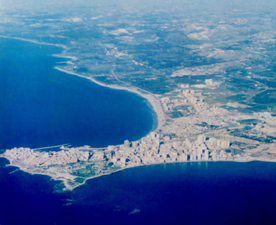 People have
occupied Tyre and Sidon on the coast of present-day Lebanon since the Bronze
Age 5,000 years ago. These ancient coastal city-states were once important trade
centers where geoarchaeologists are finding that natural hazards, shifts in
political rule and human innovation have controlled the cities’ rises and
falls in prominence over the past five millennia.
People have
occupied Tyre and Sidon on the coast of present-day Lebanon since the Bronze
Age 5,000 years ago. These ancient coastal city-states were once important trade
centers where geoarchaeologists are finding that natural hazards, shifts in
political rule and human innovation have controlled the cities’ rises and
falls in prominence over the past five millennia. Geoarchaeologists are coring beneath modern-day Sur, formerly known as Tyre, on the coast of Lebanon, hoping to pin down the locations and chronologies of its ancient harbors. Image is courtesy of Nick Marriner.
Archaeologists have known that Tyre and Sidon have long been significant as two of few sheltered harbors in the eastern Mediterranean, but “the exact location and chronologies of the two harbors have been the subject of scholarly debate for many centuries,” says Nick Marriner of the Centre National de la Recherche Scientifique in Aix-en-Provence, France.
The city-states’ periods of prominence started around 3000 B.C. and continued for the next 4,000 years, seemingly corresponding to Phoenician, Persian, Greco-Roman and Byzantine rule. In between those glory days, centuries of hardship and war, including conquerors such as Nebuchadnezzar, Alexander the Great, Christian Crusaders and the Ottomans, took their toll. Furthermore, earthquakes and at least 10 tsunamis struck the city-states between the 4th and 11th centuries, and relative sea levels rose, leading to severe damage, Marriner says.
To see what lies below the damage, Marriner and colleagues have been drilling below the Mediterranean and present-day Tyre (now called Sur) and Sidon (now called Saida) since 1998, under the auspices of UNESCO, CEDRE, the Leverhulme Trust and the British Museum. They have drilled 40 cores around both sites, combining them with “a precise topographical study of the city center” to reconstruct the position of ancient shorelines and the extent of the harbors at each time period, Marriner says. Radiocarbon dating of the layers of sediment, along with shells, seeds, wood and other remains in the layers, confirmed the existence and evolution of the ancient ports, as reported in the January Geology.
Sediments in the cores show that during the Bronze Age, the harbors of Tyre and Sidon were natural semi-open marine embayments and coves, which would have provided excellent shelter from storms. The cores next reveal “a significant rise in silts” and a change in marine fauna that indicate artificial expansion of the harbors coincident with the Phoenicians’ rise in power. At this time, trading throughout the Mediterranean picked up speed, as the new use of iron in naval construction meant that larger ships could be built that were capable of sailing much greater distances, thus raising the need for larger harbors and more “docking capacity,” Marriner and colleagues suggest.
Higher up in the cores, the researchers found evidence of hydraulic cement, indicating that when the Greeks and Romans moved into the area sometime after 332 B.C., they introduced the material to enhance harbor engineering possibilities. Sedimentation rates 10 times greater than natural levels indicate that at the technological height of the cities, during the Greco-Roman and Byzantine periods, the ports became well-protected and confined basins, and remained so until about A.D. 1000. Following that span, however, “classic” features of semi-abandoned harbors in the cores evince the economic demise of both Tyre and Sidon, the authors say.
Finding and understanding ancient harbors is “very important” for learning what life was like in ancient lands, says George (“Rip”) Rapp, a retired geologist formerly at the University of Minnesota in Duluth. “This is good research,” says Rapp, who has worked on buried harbors at Troy and other sites. The cores make it fairly easy to determine what type of harbor once was there, and thus how it was used, he says.
Furthermore, the cores are an important tool in archaeological work, which largely involves “proving or disproving” what historical documents or literature might suggest about a site, as is the case here, says Eduard Reinhardt, a geoarchaeologist at McMaster University in Hamilton, Ontario, who recently cored Roman sites south of Tyre. Such studies highlight the utility of interdisciplinary approaches, he says. Marriner and colleagues hope their work will help guide future archaeological research at Sidon and Tyre. “Both sites have rich archaeological heritages,” Marriner says, and gaining a better understanding of Phoenician maritime history should help conserve those legacies.

